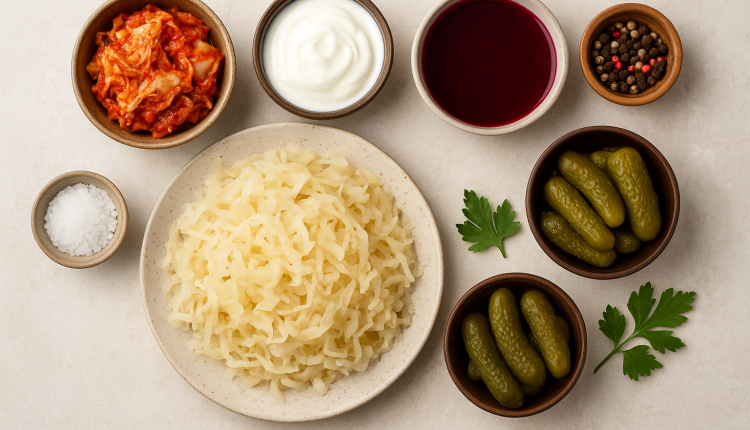Fermentation is one of the oldest culinary techniques known to humankind, transforming simple ingredients into nutrient-dense, flavor-rich staples. From sauerkraut and kimchi to miso and kombucha, fermented foods not only delight the palate but also nourish the body with probiotics, enzymes, and organic acids. Yet beyond their health benefits, ferments can serve as powerful tools for building complex flavor layers in everyday cooking.
Learning how to balance their acidity, saltiness, and umami allows cooks to elevate even the simplest dishes — giving them a depth that feels alive. Whether you’re making a salad, a soup, or a roast, incorporating functional ferments can turn an ordinary meal into a vibrant, balanced, and deeply satisfying experience.
This article explores how to properly layer flavors using fermented foods like sauerkraut, kimchi, and others, showing how these living condiments can enhance texture, aroma, and taste across cuisines.
Understanding Functional Ferments
At their core, ferments are living foods created through the action of beneficial microorganisms — bacteria and yeasts that transform sugars into lactic acid, alcohol, or acetic acid. This process not only preserves food but also amplifies its flavor and nutritional profile.
- Sauerkraut, made by fermenting cabbage with salt, develops a crisp texture and tangy, slightly sour flavor.
- Kimchi, its Korean cousin, adds layers of spice, umami, and aromatics such as garlic, ginger, and chili.
- Miso, a Japanese staple, provides deep umami richness and a subtle sweetness that enhances broths and marinades.
- Kombucha and fermented vegetables like carrots or beets introduce acidity and complexity to drinks and dishes alike.
Each ferment carries its own distinct character, and when used thoughtfully, they can work in harmony — balancing and contrasting other flavors on the plate.
The Flavor Map: How Ferments Transform a Dish
Fermented foods play several roles in flavor development:
- Acidity and Brightness – Lactic acid fermentation gives ferments their characteristic tang. This acidity cuts through richness, balancing fatty or creamy components and refreshing the palate.
- Umami and Depth – Ferments like miso, soy sauce, and fish sauce contain amino acids such as glutamate that deepen savory notes and make dishes more satisfying.
- Salt and Complexity – Salt not only preserves but also enhances flavor perception, allowing subtler notes to shine.
- Aromatics and Heat – Spices, herbs, and alliums used in ferments such as kimchi or pickled garlic introduce secondary layers of warmth and complexity.
When layered correctly, these components create harmony — where sourness brightens sweetness, umami balances salt, and texture contrasts keep the experience dynamic.
Sauerkraut: The Subtle Ferment
Sauerkraut is perhaps the most versatile of all ferments. Its clean acidity pairs beautifully with both meat and plant-based dishes.
- With roasted meats: The acidity cuts through the richness of pork, duck, or sausage, while the crispness provides a satisfying contrast.
- In salads or sandwiches: A spoonful of sauerkraut brings brightness and crunch without overpowering other ingredients.
- In soups or stews: Added at the end of cooking, it lifts the flavor with a gentle tartness, preventing the dish from feeling heavy.
For optimal layering, sauerkraut should complement rather than dominate. Think of it as a “splash of citrus” for savory foods — a finishing accent that awakens the entire dish.
Kimchi: Bold, Spicy, and Complex
Kimchi introduces a much bolder profile. Its combination of chili, garlic, ginger, and fermented fish sauce creates a multifaceted flavor that evolves as it ages.
To layer kimchi effectively:
- Balance intensity: Use small amounts of aged kimchi in cooked dishes to introduce depth without overwhelming the palate. Younger kimchi, which is fresher and less pungent, works well in salads and tacos.
- Combine with neutral bases: Rice, grains, and eggs make excellent canvases for kimchi’s spice and acidity.
- Add for contrast: Pairing kimchi with creamy or fatty foods (like avocado, tofu, or melted cheese) softens its bite and enhances mouthfeel.
In stews like kimchi jjigae, the ferment infuses broth with savory complexity while mellowing its sharpness — demonstrating how heat transforms and integrates fermented flavors.
Beyond Cabbage: Exploring Other Functional Ferments
While sauerkraut and kimchi are classics, other ferments can bring equally impressive results.
- Miso adds umami and creaminess to dressings, soups, and marinades. White miso brings mild sweetness, while red miso offers intensity.
- Fermented chili paste (gochujang or sambal oelek) provides both heat and depth for sauces and stir-fries.
- Fermented garlic honey combines sweetness and pungency — a perfect glaze for roasted vegetables or meat.
- Pickled beets and carrots introduce vibrant color and gentle acidity to salads and grain bowls.
- Fermented dairy products like yogurt, kefir, or labneh create a cooling contrast to spicy dishes.
When layering ferments, think in terms of contrast and balance: if one ingredient provides heat, add something cool or sweet; if one brings tang, pair it with umami or fat to round out the flavor.
Techniques for Layering Ferments
- Start Small, Build Gradually
Ferments can easily overpower a dish. Begin with a teaspoon or two and taste as you go. The goal is balance — to enhance, not dominate. - Use at Different Stages of Cooking
Adding ferments during cooking softens their acidity and deepens their flavor, while using them as a garnish keeps their probiotic benefits intact. Try blending both approaches: cook with a small portion for depth and finish with a fresh spoonful for brightness. - Combine Ferments Thoughtfully
Pairing multiple ferments can be rewarding but requires precision. For instance, a kimchi fried rice with a touch of miso in the sauce creates a beautiful harmony of spice and umami, while too much of both could clash. - Mind the Heat
High temperatures kill probiotics, though the flavor compounds remain. If your goal is to preserve gut-friendly bacteria, add ferments after cooking, just before serving. - Balance Texture and Temperature
Crisp, cold ferments provide contrast in warm, soft dishes. For example, topping a hot grain bowl with chilled sauerkraut or pickled onions enhances both texture and aroma.
The Health Benefits Behind the Flavor
Functional ferments are not just about taste — they also promote gut health, boost immunity, and improve nutrient absorption. The beneficial bacteria in these foods aid digestion and help balance the microbiome.
Furthermore, fermentation can reduce anti-nutrients and increase bioavailability of vitamins like B12 and K2. When incorporated regularly, fermented foods support both physical well-being and culinary creativity.
Conclusion: A Symphony of Living Flavors
Fermentation bridges tradition and innovation, science and art. It allows cooks to transform ordinary vegetables into complex, living condiments that bring flavor, health, and vitality to the table.
To master the layering of flavors with functional ferments, think of balance — acid meeting fat, spice complementing sweetness, texture enhancing temperature. With practice, you’ll discover that fermented foods are not merely side dishes but central players in the composition of a meal.
From the bright tang of sauerkraut to the fiery depth of kimchi and the savory warmth of miso, each ferment offers a unique note in the symphony of flavor. The key lies in listening — tasting, adjusting, and respecting the living energy within every bite


